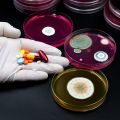New small molecule found to suppress the evolution of antibiotic resistance in bacteria
Researchers from the University of Oxford have developed a new small molecule that can suppress the evolution of antibiotic resistance in bacteria and make resistant bacteria more susceptible to antibiotics. The findings have been published in the journal Chemical Science.
The global rise in antibiotic-resistant bacteria is one of the top global public health and development threats, with many common infections becoming increasingly difficult to treat. It is estimated that drug-resistant bacteria are already directly responsible for around 1.27 million global deaths each year and contribute to a further 4.95 million deaths. Without the rapid development of new antibiotics and antimicrobials, this figure is set to rise significantly.
A new study led by researchers at the Ineos Oxford Institute for antimicrobial research (IOI) and the Department of Pharmacology at Oxford University offers hope in the discovery of a small molecule that works alongside antibiotics to suppress the evolution of drug-resistance in bacteria.
One of the ways that bacteria become resistant to antibiotics is due to new mutations in their genetic code. Some antibiotics (such as fluoroquinolones) work by damaging bacterial DNA, causing the cells to die. However, this DNA damage can trigger a process known as the ‘SOS response’ in the affected bacteria. The SOS response repairs the damaged DNA in bacteria and increases the rate of genetic mutations, which can accelerate the development of resistance to the antibiotics. In the new study, the Oxford scientists identified a molecule capable of suppressing the SOS response, ultimately increasing the effectiveness of antibiotics against these bacteria.
The researchers studied a series of molecules previously reported to increase the sensitivity of methicillin-resistant Staphylococcus aureus (MRSA) to antibiotics, and to prevent the MRSA SOS response. MRSA is a type of bacteria that usually lives harmlessly on the skin. But if it gets inside the body, it can cause a serious infection that needs immediate treatment with antibiotics. MRSA is resistant to all beta-lactam antibiotics such as penicillins and cephalosporins.
Researchers modified the structure of different parts of the molecule and tested their action against MRSA when given with ciprofloxacin, a fluoroquinolone antibiotic. This identified the most potent SOS inhibitor molecule reported to-date, called OXF-077. When combined with a range of antibiotics from different classes, OXF-077 made these more effective in preventing the visible growth of MRSA bacteria.
In a key result, the team then tested the susceptibility of bacteria treated with ciprofloxacin over a series of days to determine how quickly resistance to the antibiotic was developing, either with or without OXF-077. They found that the emergence of resistance to ciprofloxacin was significantly suppressed in bacteria treated with OXF-077, compared to those not treated with OXF-077. This is the first study to demonstrate that an inhibitor of the SOS response can suppress the evolution of antibiotic resistance in bacteria. Moreover, when resistant bacteria previously exposed to ciprofloxacin were treated with OXF-077, it restored their sensitivity to the antibiotic to the same level as bacteria that had not developed resistance.
Jacob Bradbury, IOI DPhil student and first author of the paper, said: ‘These findings suggest OXF-077 is a useful tool molecule to further study the effects of SOS response inhibition in bacteria, and for the treatment of antibiotic-resistant infections. Further work is needed to test the suitability of these molecules for use outside of lab settings, and will form part of ongoing work between the IOI and Oxford’s Department of Pharmacology to develop new molecules to slow and/or reverse antibiotic resistance.’
Dr Thomas Lanyon-Hogg, Principal Investigator at Oxford’s Department of Pharmacology said: ‘This is a great example of what can be achieved through interdisciplinary collaboration between microbiologists in the IOI and chemical biologists in Pharmacology. The AMR crisis presents technical obstacles in numerous areas, and if the challenges we face as scientists are not confined to a single scientific discipline, then the solutions will not be either.’
Notes to editors:
For media enquiries and interview requests contact Sophie Bury – sophie.bury@chem.ox.ac.uk
The paper ‘Development of an inhibitor of the mutagenic SOS response that suppresses the evolution of quinolone antibiotic resistance’ has been published in the journal Chemical Science.
About the Ineos Oxford Institute for antimicrobial research (IOI)
The Ineos Oxford Institute for antimicrobial research (IOI) is a world-leading centre of research, training and education based at the University of Oxford. The IOI is developing solutions to fight antimicrobial resistance by developing new drugs for human use and designing alternative antibiotics to use in agriculture and animal feed exclusively.
About the University of Oxford
Oxford University has been placed number 1 in the Times Higher Education World University Rankings for the eighth year running, and number 3 in the QS World Rankings 2024. At the heart of this success are the twin-pillars of our ground-breaking research and innovation and our distinctive educational offer.
Oxford is world-famous for research and teaching excellence and home to some of the most talented people from across the globe. Our work helps the lives of millions, solving real-world problems through a huge network of partnerships and collaborations. The breadth and interdisciplinary nature of our research alongside our personalised approach to teaching sparks imaginative and inventive insights and solutions.
Through its research commercialisation arm, Oxford University Innovation, Oxford is the highest university patent filer in the UK and is ranked first in the UK for university spinouts, having created more than 300 new companies since 1988. Over a third of these companies have been created in the past five years. The university is a catalyst for prosperity in Oxfordshire and the United Kingdom, contributing £15.7 billion to the UK economy in 2018/19, and supports more than 28,000 full time jobs.
 Nearly 500,000 children could die from AIDS-related causes by 2030 without stable PEPFAR programmes, Oxford experts estimate
Nearly 500,000 children could die from AIDS-related causes by 2030 without stable PEPFAR programmes, Oxford experts estimate
 Expert Comment: Why has Trump launched so many tariffs and will it cause a recession?
Expert Comment: Why has Trump launched so many tariffs and will it cause a recession?
 Antibiotic resistance genes are spread more widely between bacteria than previously thought
Antibiotic resistance genes are spread more widely between bacteria than previously thought
 An estimated 1.2 million people died in 2019 from antibiotic-resistant bacterial infections
An estimated 1.2 million people died in 2019 from antibiotic-resistant bacterial infections
 A novel strategy for using compounds as ‘anti-evolution’ drugs to combat antibiotic resistance
A novel strategy for using compounds as ‘anti-evolution’ drugs to combat antibiotic resistance